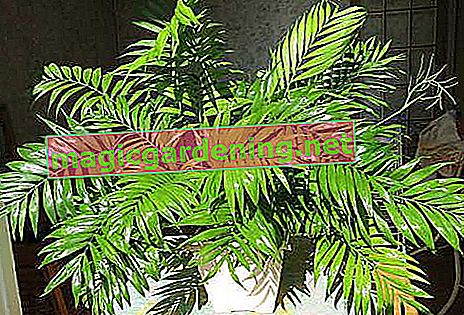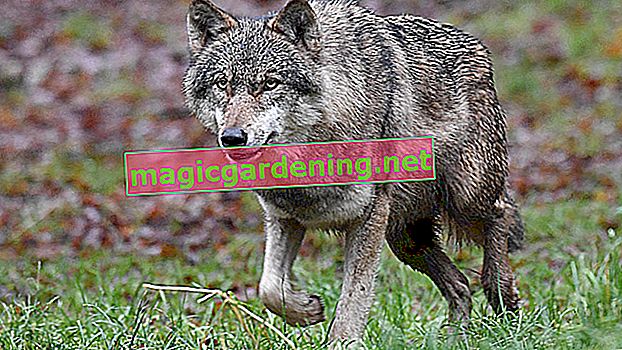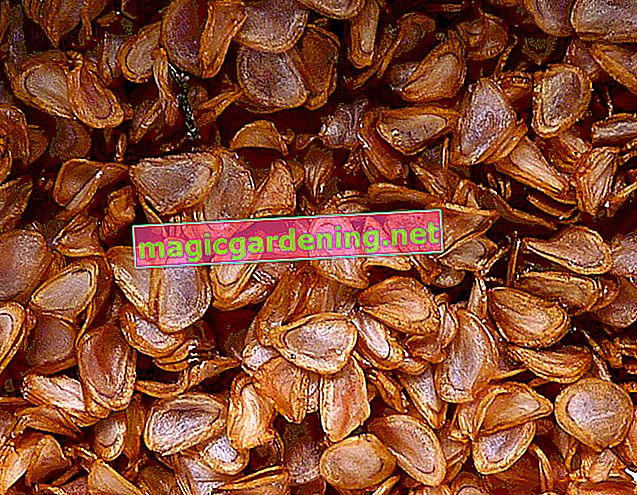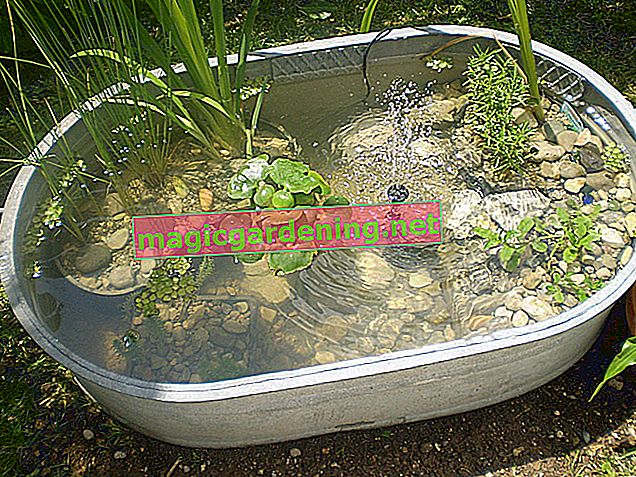
origin
The mountain palm, botanically Chamaedorea, is a medium species-rich plant genus. Their total of 104 species are, however, quite different. Their areas of origin extend from Mexico to Brazil in South America. As their name suggests, most of the species come from higher habitats, only a few are also native to the lowlands. What all species of the Chamaedorea have in common, however, is their settlement in the undergrowth zone of moist forests. They are therefore adapted to more partially shaded lighting conditions.
also read
- The mountain palm tolerates a darker location
- Why does the mountain palm get brown leaves?
- Does the mountain palm form a flower as a houseplant?
Of the different species of Chamaedorea, only the Chamaedorea elegans, the Mexican or dainty mountain palm, is actually relevant for the local houseplant culture. As its German name suggests, it comes from the mountainous regions of Mexico and Guatemala.
The origin of the mountain palm at a glance:
- Areas of origin of the 104 species extend from Central to South America
- Most species from mountain regions
- Undergrowth plant from moist forests
- Mexican mountain palm from Mexico and Guatemala cultivated as a houseplant in this country
growth
As already mentioned above, the species of the genus Chamaedorea are quite diverse - that already applies to their respective habitus. There are both erect, prostrate or even climbing species. But all are rather small to medium-sized. Most species are single-stemmed, others also form clumps.
The Chamaedorea elegans, which is relevant for Central European houseplant cultivators, grows as an upright tree with a slender trunk and an umbrella-like tuft of leaves. In its home country it grows up to 3 meters high and spreads its crown by 2 meters. In indoor culture, however, it usually only reaches a height of 1.30 meters that is easier to handle.
Houseplant
As a houseplant, the Chamaedorea elegans is extremely easy to care for and is therefore also suitable for beginners. She does not need excessive attention and is very tolerant of caregiver errors.
Continue reading
leaves
The mountain palm is valued as an ornamental house plant because of its delicately pinnate, fresh green and slightly shiny leaves. They are positioned close to each other at the top of the trunk and have a filigree pinnate structure of 20 to 40 narrow, lanceolate single leaves up to 15 centimeters long. With the medium-length stem flattened at the top and round at the bottom, the palm fronds reach a total length of around 60 centimeters.
blossom
The Mexican mountain palm forms very filigree, widely fanned flower panicles with small, yellowish, spherical flowers over the entire vegetation period from spring to autumn. Visually, they do not stand out particularly strongly from the leafy green, but the attentive observer can certainly enjoy their delicate structure. The mountain palm is dioecious, i.e. separate sexes. If you have a female specimen, the flower will also fill the room with a pleasant scent.
Continue reading
Which location is suitable?
As an undergrowth, the mountain palm is of course not used to direct sunlight. Their equatorial area of origin still requires a lot of brightness. In the room, you should therefore offer it a light location where it is protected from direct sunlight. In summer you can also put them outside, but of course in a shady spot here too.
Since the Chamaedorea elegans comes from the Central American mountain regions, it practically does not need tropical forest temperatures. A living temperature of 20 ° C, which is also comfortable for us, is ideal for them. In winter, on the other hand, if you expect flowers to develop in the next vegetation phase, it needs cooler values of around 12 to 16 ° C. A place to spend the winter in an unheated stairwell is ideal - and when you come home on cold, wet winter days, it may also give you a little tropical joy.
The location requirements at a glance:
- Mountain palm should be light but protected from direct sunlight
- Temperatures in summer moderately warm, around 20 ° C
- Putting out possible, but shaded
- Cooler in winter (12-15 ° C), so that there is a temperature stimulus for blooming in the next spring
Continue reading
What soil does the plant need?
The mountain palm should stand in a loose, not too compact substrate. Potting soil is particularly suitable for palms or herbs. You can make the soil a little more humorous with a little compost. Good drainage from coarse sand or volcanic rock is definitely recommended because of the relatively high sensitivity to waterlogging.
The pH should be more alkaline than acidic.
To note:
- Permeable substrate made from (special palm or herb) soil and some compost
- Drainage from coarse sand or volcanic rock
- pH value rather alkaline
Water the mountain palm
When watering the mountain palm, the simple rule of thumb applies: not too little and not too much. Specifically, this means: it should be kept evenly moist and not allowed to dry out, but waterlogging should also be avoided whenever possible. Give it plenty of water, especially in hot, dry periods in summer and make sure that the pot ball always remains moist. However, water must not stand permanently in the coaster. In any case, it should be soaked up by the plant before watering again.
A dip once a week is also recommended: immerse the pot completely in water and then let it drain well.
During the winter break, reduce the watering a little, but even then the substrate should always remain slightly moist.
Watering rules again in brief:
- not too little, not too much
- always keep moist, but avoid waterlogging
- Occasional immersion baths recommended in summer
- keep only slightly moist in winter
Hydroponics
The Chamaedorea elegans can also be kept in hydroponics. It is particularly recommended for beginners or offices as it requires even less attention when watering and maintaining. Overall, hydroponics is also somewhat more hygienic, as pests and allergens have less breeding ground for colonization. Particularly sensitive people can also benefit from this.
However, it is important that the decision to use hydroponics is made right at the beginning. The mountain palm does not tolerate a change from soil culture to hydroponics - its roots have to be used to this “clinical” water and nutrient uptake from the start.
Place the mountain palm for hydroponics using the classic method in a planter with expanded clay (€ 17.50 at Amazon *) and a water-nutrient solution as a base. A water level indicator is important to always stay informed about the hydrostatic status and to be able to fill up on time.
What to consider with hydroponics:
- Suitable for beginners, offices and allergy sufferers
- If so, cultivate this way from the start
- Classic variant is best: expanded clay substrate over water-nutrient solution with water level indicator
Continue reading
Fertilize mountain palm properly
You should only fertilize a mountain palm when it is old. In the first year of life, the plant should have the opportunity to develop its roots well. Later you can give her some universal liquid fertilizer every now and then in the growing season from early spring to late summer. However, you should dose this weakly and keep an interval of at least 2 to 3 weeks between the fertilizers.
Diseases
Diseases are generally not known in the mountain palm.
Continue reading
Pests
However, pests can occasionally attack the Chamaedorea elegans. It is most likely to be attacked by the most common of all indoor plant parasites, the spider mites and scale insects. In both cases, heating air that is too dry is the cause. If the substrate is too wet, fungus gnats can also settle.
Spider mites
These tiny little animals colonize many houseplants and feed on their sap. The damage is first expressed by the fine webs with which the reddish to yellowish or greenish mites cover their host plants. Later, small dots appear on the leaves, which gradually expand into larger spots. At some point the leaves roll up and are shed.
Spider mite infestation can, however, usually be recognized early on and controlled through the web. The spray and foil method has proven itself here. First, shower the palm under a stronger jet of water to mechanically remove the pests. In order to eradicate all of them, then completely cover the plant with a film, which you close as airtight as possible at the bottom. Below that, the mites die within a week.
Scale insects
These somewhat larger parasites also feed on the sap of their host, leaving behind excretions (honeydew) that clog the area around the houseplant.
The best way to combat scale insects is mechanical, by wiping them off the leaves with a damp cloth. Then apply a spray of garlic, nettle or tansy stock. If the infestation is more persistent, you can also use an oil preparation that will choke the pests.
Sciarid gnats
Sciarid gnats prefer to settle in wet soil. For this reason alone, you should not keep the mountain palm permanently too moist. The parasites are easy to spot because they buzz around the plant every time it is watered. Then you should act quickly, because the larvae deposited in the soil eat all the lower parts of the plant, especially the roots.
You can contain a large part of the population with sticky yellow boards. A completely biological method is the use of beneficial organisms such as nematodes, which you can buy in specialist shops. Let these go on the sciarid gnats, they satisfy their hunger immediately.
As a preventive measure, you can also keep carnivorous plants in the room - they will also do a reliable service.
Brown leaves
dryness
Brown leaves are in most cases an indication of drought in the mountain palm - either it has not received enough irrigation water from below or the surrounding air is too dry for it. In any case, keep the ball of the pot evenly moist - or simplify the water supply with hydroponics. You can place a bowl of water on the heater to keep the humidity high. You also benefit from this. An occasional spray shower is also good for the mountain palm.
sunburn
Another reason for brown leaves can be sunburn. As an undergrowth, the mountain palm cannot tolerate direct sunlight. So protect them in the light location that is still necessary by shading other plants or a thin cloth sail.
Continue reading
Brown tips
If the leaf tips of the mountain palm turn brown, the underlying causes are the same as with completely brown leaves - here you only recognized the problem earlier. Of course, this also makes it easier to rectify. Immediately increase the amount or frequency of watering and, if necessary, increase the humidity in the room.
If the sun troubles the mountain palm too much, shade it lightly.
Continue reading
Propagate mountain palm
Saplings
The easiest way to propagate a mountain palm is to use saplings. She regularly forms these in the lower plant area as side shoots. You can easily cut them off with a sharp knife and put them in a planter with potting soil. Put it on in a bright, warm place protected from direct sunlight, keeping it evenly moist - a uniformly moist, warm microclimate that you can achieve by covering it with a film is beneficial for growth.
Seed cultivation
Another method is to grow seeds. You can either buy seeds from specialist retailers or take some from two mother plants yourself. However, this requires a little skill and motivation. Because first of all you need a male and a female plant specimen so that fertilization is possible. When both specimens are in bloom, use a brush to alternately paint over the male and female flowers over several days. You can then take the seeds from the ripe, blackish fruits.
Growing the seeds again requires a lot of patience. Because they first have to be soaked in water for about two days so that the hard capsule dissolves. Once that's done, put them in seed pots (€ 14.90 at Amazon *) and place them in a protected, bright, warm and evenly humid place - a mini greenhouse offers the best chance of success. (€ 6.96 at Amazon *) Alternatively, you can also create a suitable microclimate with a film cover.
When the seedlings show up, they will need some ventilation. When you have reached a stable size, you can move them to larger planters and continue to cultivate them appropriately.
Continue reading
Is mountain palm poisonous?
It is not entirely clear whether the mountain palm is poisonous. It is often classified as harmless, and some experts attribute slight toxicity to it due to the allegedly contained saponins. In any case, the toxicity, if present at all, is only weak. In order to minimize risks, however, mountain palms should be placed higher up in households with small children and pets and any fallen plant parts should be collected and disposed of.
Continue reading
tip
If you value the flowers, which are not particularly conspicuous but are very pretty, cut them off immediately after they have bloomed. This generally promotes new formation.
sorts
Chamaedorea elegans Bella
This is the most common variety of the Mexican mountain palm that can be purchased locally. Occasionally one also finds varieties of other species such as the particularly filigree Chamaedorea metallica or the feathered Ch. Ernesti-augustii.
The Chamaedorea elegans Bella is characterized by its compact growth and its shapely, fresh green palm fronds. It grows up to 1.30 meters high and shows the typically delicate, panicle-shaped inflorescences with yellowish globular flowers. It can bloom throughout the growing season.
 Air-purifying indoor plant mix 'Fresh Air' 18.63 EUR Buy at baldur
Air-purifying indoor plant mix 'Fresh Air' 18.63 EUR Buy at baldur  Chamaedorea Palme 7.35 EUR Buy at baldur Indoor
Chamaedorea Palme 7.35 EUR Buy at baldur Indoor  plant mix 'Classic' 17.65 EUR Buy at baldur
plant mix 'Classic' 17.65 EUR Buy at baldur








